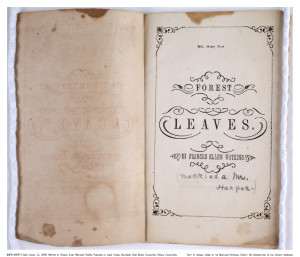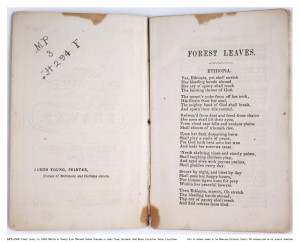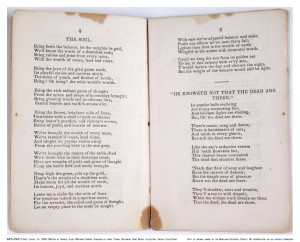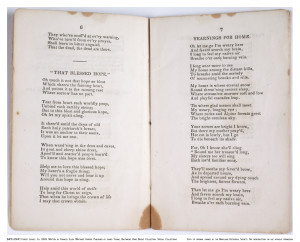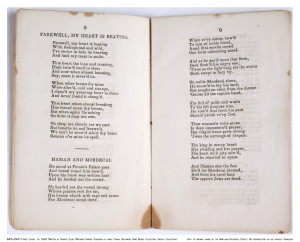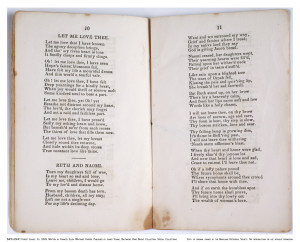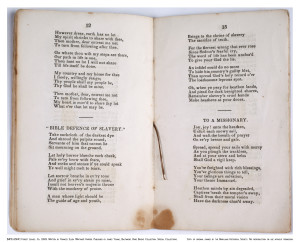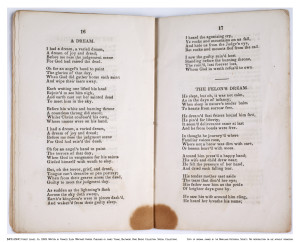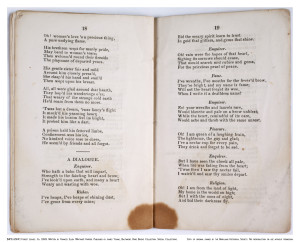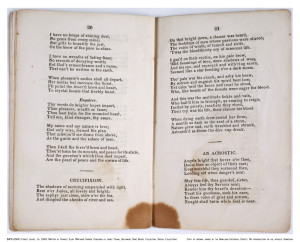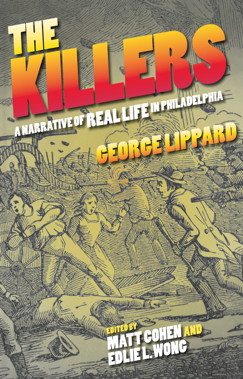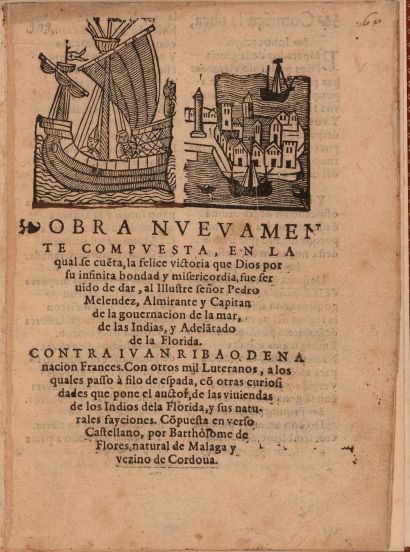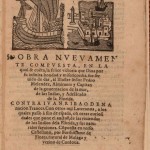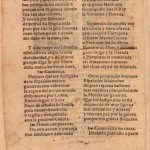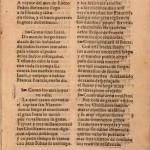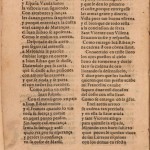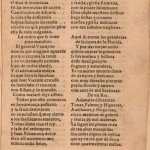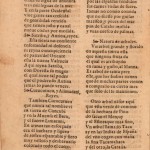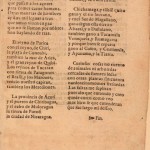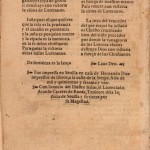La felice victoria: Bartolomé de Flores’s A Newly Composed Work, Which Recounts the Happy Victory That God, in His Infinite Goodness and Mercy, Was Pleased to Give to the Illustrious Señor Pedro Menéndez (1571)
Translated by E. Thomson Shields Jr. and Thomas Hallock
In spring 1562 the French explorer Jean Ribault cruised the north-flowing St. Johns River, what he called the “River of May,” below present-day Jacksonville, Florida. Two years later, the Calvinist Huguenot explorer René Goulaine de Laudonnière established a fort nearby, challenging shipping lanes off the Atlantic coast. The French Protestant threat caught the attention of Roman Catholic King Philip II, who sent the formidable Asturian Pedro Menéndez de Avilés to eradicate the fort and establish a Spanish fort there. Acting as Adelantado, an entrepreneurial governor who invested his own money in the enterprise, Menéndez answered his charge with military and religious zeal. He demolished the French fort, slaughtered most of the Huguenots, and established St. Augustine—a city that now bills itself as the nation’s oldest continuously occupied city. The year 2015 marks the 450th anniversary of these events, and with the commemoration of St. Augustine’s founding, it serves to recognize that the European contest for la Florida held literary as well as historical importance.
An outsized body of writing emerged from the struggle for this obscure corner of empire, one work being Bartolomé de Flores’s 1571 La felice victoria que Dios por su infinita bondad y misericordia, fue seruido de dar, al Illustre señor Pedro Melendez (The Happy Victory that God, in His Infinite Goodness and Mercy, Was Pleased to Give to the Illustrious Señor Pedro Menéndez). Flores’s poem, published in eight quarto (20 cm x 15 cm) pages and translated here for the first time, has three parts. The first part includes a brief invocation, followed by a description of Menéndez’s charge against the Huguenot settlers, which Flores freely sets against the range of Spanish conquests in the Americas. The second part celebrates the beauty, natural resources, and people of la Florida—again, situating the wonders of one colony against broader imperial claims. A villancico, or carol, finally, sings of a joust, offering Menéndez’s victory as a martial conquest for the Christian realm. The parts may appear disjoined, but in its loose associations, La felice victoria provides a valuable window into Spanish perceptions of empire.
Flores’s verse tribute adds to the substantial—if undervalued—literature about St. Augustine’s founding, a body of work that cuts across several languages and rhetorical positions. Before the Spanish attacked the French Huguenot colonial efforts, Jean Ribault, in England because of the religious wars in France, penned The Whole & True Discouerye of Terra Florida (1563), a book-length promotional account of the St. Johns expedition that mixed pastoral jubilation with topographic detail. At least two early English poems described the far-off territory. Robert Seall’s 1563 broadside, A Commendation of the Adventerus Viage of the Wurthy Captain M. Thomas Stutely Esquyer and others Towards the Land Called Terra Florida, paid tribute to Thomas Stucley (or Stuckley), who vied to set up a colony there. And a slightly better-known 1564 ballad would ask, “Have you not h[e]ard of floryda,” where natives “Fynd glysterynge gold / And yt for tryfels sell?” The swift Spanish victory and dubious Huguenot defense in 1565 sparked a considerable body of writing, much of it legal or procedural, and often with a rhetorical agenda. Multiple biographies of Menéndez chronicle the battle for la Florida, and French survivors penned two accounts. Laudonnière’s L’histoire notable de la Floride (1586) was published posthumously and translated in part by Richard Hakluyt, while Nicolas Le Challeux offered his own version in Discours de l’histoire de la Floride, contenant la trahison des Espangnols, contre les subjects du Roy (1566). The most famous record of this imperial struggle, finally, came from Jacques le Moyne de Morgue, whose 1591 Brevis narratio eorum quæ in Florida Americæ provincia Gallis acciderunt … (Brief Narration of Those Things Which Befell the French in the Province of Florida in America …) included Theodore de Bry’s engravings of native Timucuans, spurious images of Florida’s “first people” that circulate widely to this day.
Many of these sources are known to historians and critics, although La felice victoria has escaped attention. Scholarship on this and other scenes of imperial struggle has remained fixed on the accounts of participant-observers; quasi-literary works have found their way into undergraduate textbooks and appear ripe for commentary, even by scholars who do not read Spanish. But a poem, especially one by a non-participant, does not carry the same historical weight, leading to its neglect. Yet La felice victoria illustrates how empire was understood in Spain, how victories were celebrated, and how the little-regarded territory of la Florida fit alongside more significant triumphs.
What little we know about Bartolomé de Flores comes from his work. Between 1570 and 1572, he apparently experienced a burst of energy, resulting in five verse pamphlets. According to La felice victoria, Flores was “natural de Malaga y vezino de Cordoua,” a Malagueño living in Córdoba. Internal evidence highlights Flores’ being Malagueño, especially the presence of seseo, the Andalucían pronunciation of z and s both pronounced like the letter s in English. Another pamphlet poem identifies Flores as a “colchero,” or quilter, suggesting he was a middle-class tradesman. These verse pamphlets reflect everyday attitudes of the times about Spain’s engagement with the world. Some are laudatory, praising victories in the reconquest of the Iberian Peninsula or celebrating the marriage of Princess Anna, daughter of the Holy Roman Emperor Maximilian II. Others tell of the 1570 earthquake in Hungary, floods in Flanders, and losses by the Muslim armada of Turkey. The range of subjects indicates that Bartolomé de Flores wrote from reports, not experience. As such, La felice victoria is a valuable record of popular attitudes and beliefs—a source of insight into middle-class Spanish attitudes toward imperial rivalries, perceptions of native peoples and resources in places like la Florida, and for the suggestion of how victories like the one by Menéndez were celebrated.
This translation continues the effort of early Americanists to recover forgotten traditions for twenty-first-century readers. The documentary transcription of the original is included because, although there was an edition of the poem published in 1898, it contains errors and takes a few liberties with the text without marking them. Regarding form, the bulk of La felice victoria is in copla real (with exceptions), i.e., stanzas of ten rhymed octosyllabic lines, with the closing villancico in mainly stanzas of eight octosyllabic lines. Our translation does not attempt the impossible task of replicating the rhythm or rhyme scheme, and because Flores often sequenced his thoughts around end-rhymes, we take some liberty in reordering the lines for fluidity. The goal has been to render a poem in English, not a literal rendering of the Spanish. Those who want to compare the translation with the Spanish are encouraged to use the side-by-side transcription and translation or to consult the page images.
The editors initially worked separately and unbeknownst to one another. E. Thomson Shields Jr. prepared the transcription from a copy at the John Carter Brown Library, and we later consulted scans generously provided by the JCB. The following translation was developed by comparing the two versions, combing through each line for meaning, continuity, and fluidity. Our goal is to present a work that, we feel, helps alter the shape of the early American canon, that argues further for the multilingual roots of what would later become part of the United States, and that documents the difficult attempts to understand events in a new world that cut across imperial boundaries, religious and linguistic differences, and, of course, an ocean.
❧ Obra nvevamente compvesta, en la qual se cuẽta, la felice victoria que Dios por su infinita bondad y misericordia, fue seruido de dar, al Illustre señor Pedro Melendez, Almirante y Capitan de la gouernacion de la mar, de las Indias, y Adelãtado de la Florida.
❧ A newly composed work, which recounts the happy victory that God, in His infinite goodness and mercy, was pleased to give to the illustrious señor Pedro Meléndez,[i] Admiral and Captain of the government of the seas, of the Indies, and Adelantado of la Florida.
Contra Ivan Ribao de na [sic] nacion Frances. Con otros mil Luteranos, a los quales passo à filo de espada, cõ otras curiosidades que pone el auctor, de las viuiendas de los Indios dela Florida, y sus naturales fayciones. Cõpuesta en verso Castellano, por Bartholome de Flores, natural de Malaga y vezino de Cordoua.
Against Juan Ribao of the French nation, with another thousand Lutherans who met the blade of the sword, and with other curiosities provided by the author, on the dwellings of Indians of
la Florida, and their natural features.
[ii] Written in Castilian verse by Bartolomé de Flores, a native of Málaga and resident of Córdoba.
❧ Comiẽça la obra,
❧ Inuocacion.
Emperador de la gloria
Dios poderoso clemente
haz profunda mi memoria
porque con tu gracia cuente
vna tan alta victoria,
Y vos virgen soberana
despertad mi lengua ruda
pues por vos la gẽte humana
tuuo redempcion y ayuda
del daño de la mançana.
Y a mi torpe entẽdimiẽto
ofuscado en negra bruma
dad claridad, y a mi pluma
porque diga lo que siento
desta nueua en breue suma,
❧ The Work Begins,
❧ Invocation.
Emperor of all glory,
Merciful and Powerful God,
grant my memory profundity
so that, by your Grace,
I may tell of a high victory.
And you, the sovereign Virgin,
awaken my crude tongue,
because through you all humanity
has received help and redemption
from the damning apple.
And to my slow understanding
now obscured in black fog,
grant clarity, so this pen
may recount shortly, in brief,
my feelings about this news,
❧ Comiença.
Despues q̃ el rey sinsegũdo
de la Española nacion
gouierna con discrecion
la region del nueuo muudo [sic]
descubierta por Colon.
Embio segun se halla
Naos de armada de Seuilla
para mejor descubrilla
y regilla y conquistalla
con la gente de Castilla.
❧ It Begins.
Ever since the peerless
king of the Spanish nation
governed with discretion
that part of the New World
discovered by Columbus,
he sent, as can be seen,
an armada from Sevilla
for its greater discovery,
conquest and government
by the people of Castilla.
❧ Prouincias ganadas.
Do con animo y pujança
con semblante denodado
la mayor parte han ganado
hiriendo a punta de lança
con coraçon esforçado
Y haziendo a nuestra grey
esta nacion Indiana
de la gente Mexicana
se conquisto por el Rey
la Veracruz y Hauana.
Siguiendo de aquesta vez
la victoria y buen estrena
gano luego a Cartagena
el fuerte Martin Cortes
a Perù con sancta Elena.
Nombre de Dios, y Hõduras
gano luego y la Dorada
a Pamplona la nombrada
las Amazonas y alturas
del Gran reyno de Granada.
Otras prouincias mayores
Españoles subjetaron
do gran riqueza hallaron
mas nuestros conquistadores
la Florida no ganaron.
Que los Indios dela tierra
despues de ser muy ligeros
son indomitos y arteros
y truecan paz por la guerra
porque son grãdes flecheros.
❧ Provinces Won.Where with courage, powerand with bold countenance,
through valiant hearts
and the point of the spear,
the greater part has been won,
and this Indian nation
of Mexican people,
was added to our flock,
Veracruz and Havana were
conquered in the King’s name.
Following that periodof victory and great gifts,
[iii]the mighty Martín Cortés
[iv]then won Cartagena, and through
Santa Elena,
[v] he took Peru.
Nombre de Dios and Honduras
were next won and La Dorada,
then to the famed Pamplona,
to the Amazon and the heights
of the great Kingdom of Granada.
Other greater provinceswere made subjects of the Spaniards,
where they found great riches,
but our conquistadors
could not take
la Florida.
For the Indians of that land,
besides being very agile,
are indomitable and artful,
and because they are great archers,
they trade peace for war.
❧ Como salto en tierra.
Dexando pues esto a parte
de su viuienda y hechura
recontara mi escriptura
de la batalla vna parte
lo de mas de su natura
A veynte del mes de Enero
Pedro Melendez llego
a la Florida y salto
en tierra, y el buen guerrero
su gente desembarco.
❧ How He Reached Land.Leaving aside, then, the restof their life and qualities,
my words will recount
but one part of their nature,
that being the battle.
On the twentieth of January
Pedro Meléndez arrived
in Florida, made landfall,
[vi]and there the good warrior
made his people disembark.
❧ Como vino Iuani.
Do mando luego hazer
alarde de sus Soldados
do todos fueron juntados
para vencer el poder
delos Indios esforçados.
Y estando cabe la mar
con toda su compañia
contra los nuestro venia
Iuani, y empeço a hablar
Francia Francia, en este dia.
❧ How Juani Arrived.[vii]The governor next ordereda muster of his soldiers,
who gathered in formation
to defeat the force
of valiant Indians.
And close by the sea,
with all his company
against ours came Juani,
who had started this day
saying France, France.
❧ Como los metio por vn valle.
La qual razon entendio
el capitan san Vicente
donde luego al continente
el gran Iuani lo metio
por vn valle con su gente.
Veynte y tres millas corrierõ
los Christianos como digo
con aspero desabrigo
y en poco tiempo se vieron
con Iuan Ribao su enemigo.
❧ How He Led Them through a Valley.
The captain San Vicente
then understood who was
nearby on the continent,
the great Juani led him through
a valley with his people.
These Christians, as I said,
ran twenty-three miles,
raw and without cover,
and shortly found themselves
with their enemy, Juan Ribao.
❧ Como los nuestros mataron dos centinelas.
Luego la lengua Iuani
reconocio los paueses
y los luzientes arneses
y a los nuestros dixo ansi
veys a do estan los Franceses
Luego con gran vigilancia
los nuestros ponen sus velas
y encendidas sus candelas
delos Ereges de Francia
mataron dos centinelas.
❧ How Our Soldiers Killed Two Sentinels.
Then the interpreter Juani
spied the pavises, the shields,
and the glowing armor
and he said to our men,
do you see the Frenchmen?
Then with great reverence
our men took their candles
and lit their fuses,
killing two of the French
heretic sentinels.
❧ Como quemarõ el fuerte.
Con esta buena suerte
los nuestros encuentrã luego
y el timulto pueblo ciego
paso dolorosa muerte
con mil maneras de fuego.
su murallon de faxina
quemo nuestros Adelantado
dexando despedaçado
el fuerte y su larga mina
de tierraplene cercado.
❧ How They Burned the Fort.With this stroke of luck,our soldiers discovered them,
and wreaked havoc on the blind people,
bringing a painful death
with a thousand licks of flame.
Our
Adelantado burned down
the daubed wood walls,
leaving the fort in pieces
and the long mine
of terreplein besieged.
[viii]
❧ Como mataron treziẽtos.
Fue cosa de grande espãto
ver los Christianos inuitos
matar a quellos malditos
y su muy esquiuo llanto
dando temerarios gritos
Trezientos y treynta y vno
matan sin dalles clemencia
que no valio su potencia
mas seys cientos de consuno
huyeron sin resistencia.
❧ How They Killed Three Hundred.It was a frightful sightto see the unconquered Christians
slaughtering the damned,
with those heretics crying
back in contempt and scorn.
Three hundred and thirty one
were killed without clemency,
[ix]their strength was useless,
and six hundred more fled,
without any opposition.
❧ Como se retiro Iuan Ribao.
Los Españoles christianos
van matando, y van hiriendo
y ellos se van recogiendo
y España Vandalianos
la victoria van siguiendo
Con arcabuzes y lanças
les dauan guerra sangrienta
y porque entendays la cuẽta
enel campo de Matanças
el Iuan Ribao se aposenta.
❧ How Juan Ribao Retreated.The Spanish Christianswent killing, wounding,
and the French began retreating,
and so the vandals of Spain
[x]secured their victory.
With harquebus and lance,
they waged bloody warfare,
and so that you understand the story,
Juan Ribao takes his place
in the
campo de Matanzas.
[xi]
❧ Como le embio vn correo.
Despojado de su arreo
por seguir tal interesse
a Melendez le paresce
embiar luego vn correo
a Iuan Ribao que se diesse,
Diziendole por su carta
que se diesse a sus prisiones
con amorosas razones
y que se rinda y se parta
el con todos sus varones.
❧ How He Sent a Courier.
Taking off his battle gear
to pursue the course
he then thought proper,
Meléndez sent a courier
with a letter to Juan Ribao,
establishing in writing,
on clement terms, that Ribao
should be put in chains
and surrender his position
as well as all his men.
❧ Como pidio vn cofre Iuan Ribao.
Con el mensagero vn paje
a Iuan Ribao embio
y el Frances quando lo vio
toda su fuerça y coraje
en aquel punto perdio.
Sin hazer casi mudança
lenta su fuerça y ardil
quiso ver por su esperança
y perder la confiança
vn su cofre de Marfil.
❧ How Juan Ribao Asked for a Coffer.
A messenger and page
were sent to Juan Ribao,
and when the Frenchman
saw it, he lost all
courage and resolve.
He barely moved a muscle,
ardor and force slackened,
all hope and confidence
were gone, he wanted to see
his own coffer of ivory.
❧ Como se lo llevo sant Vicente.
Do mando que se tornasse
el paje y el mensagero
y que le den lo primero
el cofre, porque entregasse
las armas gente y dinero,
Vista pues tan buena estrena
y el bien que de todo resta
a la conclusion de sexta
Sant Vicente con Villena
lleuaron cofre y repuesta.
❧ How San Vicente Took It to Him.He asked that the pageand the messenger return,
and when they gave Ribao
the coffer, so he could surrender
his arms, his money and men,
it was seen as a good start,
a good sign for the remainder,
and as the noon hour closed,
[xii]San Vicente returned with Villena,
bearing the chest and response.
❧ Como entrego Iuã Riboa, vna cadena oro cõ vna llaue.
Conuertido en triste lloro
los ojos puestos al cielo
lleno de tormento y duelo
saco su cadena de oro
llorando su desconsuelo,
Y dixo pues que los hados
quieren que tan presto acabe
mi Francelini canabe
saquen doze mil ducados
del cofre con esta llaue.
❧ How Juan Ribao Delivered a Gold Chain with a Key.Moved to mournful tears,
crying over his misfortunewith eyes pressed to the sky,
filled with torment and grief,
Ribao removed his golden chain.
And as he declared, the fates
had wanted this sudden end,
my Francelini Canabe,
[xiii]and with this key he drew
twelve thousand ducats from the chest.
❧ Como se entrego cõ la gẽte.
Enel arena arrojo
su cadena tan preciada
y en ella la llaue atada
y sant Vicente allego
para quitalle la espada,
Mirando con buen subjeto
quan pocos le quedan viuos
de sus Luteros esquiuos
con los demas en efecto
vino a darse por captious.
Y al tiẽpo q̃el sol doraua
los dos cuernos con su rayo
a los diez y seys de mayo
el alua se leuantaua
en las montañas de acayo
Con el color de difunto
la vida esta desseando
sospira siempre llorando
viendo en quã pequeño pũto
esta su vida colgando.
❧ How He Surrendered with His People.Onto the sand he threw
his chain and the attached
key, so precious to him,
and San Vicente stepped forward
to strip Ribao of his sword.
Noting rightly how few
of the wild and disdainful
Lutherans remained left,
Ribao surrendered himself
as captive, along with the rest.
And on the sixteenth of May,the morning broke, with the golden
rays of the sun splitting
the two horns of Taurus
over the mountains of Acaea.
[xiv]The color of a corpse,
still longing for life,
Ribao cried with each breath,
recognizing the tiny point
upon which his life now hung.
❧ La orden que se tuuo para matallos.
El general Vizcayno
manda que ninguno aguarde
porque cerraua la tarde
y en vn hermoso camino
hizo de todos alarde,
Y el adelantado ensaya
lo que bien le satisfaze
que sant Vicente cerrasse
en haziendo el vna raya
con Ribao, y lo matasse.
❧ The Order He Had to Kill Them.
The Biscayne general
ordered that none delay,
the afternoon was ending,
and a handsome path was made
by the men stationed on display.
And the Adelantado declared
it would satisfy his will
for San Vicente to finish
the deed with a stripe
on Ribao, killing him.
❧ Como matarõ seys ciẽtos.
Todos por este concierto
en hordenança passaron
y la señal denotaron
en conclusion q̃ muy cierto
a los seyscientos mataron,
Todos dizen viua el rey
y la fe del redemptor
y Iuan Ribao con dolor
dixo alli memento mei
misericordia señor.
Alli quedo concluyda
la defensa Luterana
y por la gente Christiana
el reyno dela Florida
y sancta yglesia Romana,
con su poder fulminante
Dios cũple nuestros desseos
haga fiestas y torneos
nuestra yglesia militante
con tan subidos tropheos.
❧ How They Killed Six Hundred.Everyone was in agreement,the order was sent down,
and when the sign was given,
in short, it was determined
that they kill the six hundred.
They repeated, long live the King
and the faith of the Redeemer,
and Juan Ribao, in anguish,
recited there his
memento mei[xv]pleading his Father for mercy.
And so the Lutheran defensesin the kingdom of Florida
were brought to an end
by the Christian people
and the All Powerful
holy Roman church.
As God grants our wishes
with such fine trophies,
our triumphant, martial church
holds tourneys and feasts.
❧ Aqui se tratan las grandezas de la rierra [sic] de la Florida.
Y por dar mejor auiso
quiero contar la grandeza
la hermosura y belleza
deste fertil parayso
su gente y naturaleza,
Es vn nueuo mundo lleno
de deleytes y frescuras
con muy diuersas pinturas
prado florido y ameno
con aues de mil hechuras.
❧ Here Is Treated the Grandeur of the Land of la Florida.
And to give better notice
I wish to recount the beauty,
the loveliness and grandeur
of this fertile paradise,
its people and nature.
It is a new world filled
with delights, fresh breezes
and varied painterly scenes,
graced with fields and flowers,
and birds of a thousand kinds.
❧ De vn Rio.
Animales diferentes
Tunas, Palmas, y Higueras,
Auellanos, y Nogueras,
cinco maneras de gentes
y frutas del mil maneras.
Ya segun mi pluma toca
de tan altas marauillas
son cosas dignas de oyllas
que ay vn rio que de boca
tiene quatrocientas millas.
❧ Of a River.Animals of all types,palms, figs, and prickly pear,
walnut and hazelnut trees,
fruits of a thousand kinds,
and five races of people.
[xvi]Now my quill will sing
of such lofty marvels,
things worthy of hearing,
[xvii]including a river that runs
four hundred miles to its mouth.
❧ Gentes de nueue codos.
Y nauegando su altura
cosa digna de contar
puedo por cierto affirmar
tener su legua de anchura
tres mil leguas de la mar
Y en la parte Ocidental
viue gente tan crescida
de gentilidad vencida
que tienen justo y caual
nueue codos por medida.
❧ People Nine Cubits High.And sailing its length,a thing worthy to recount,
I can affirm with certainty
that it is one league wide
three thousand leagues
from the sea.
And in the western parts,
there lives a conquered
pagan people who exactly
stand nine cubits high.
[xviii]
❧ Satriba, y Autina, reyes.
Esta tierra no consiente
enfermedad ni dolencia
ni reyna concupiciencia
de partes del Oriente
esta la nueua Valencia
Aqui reyna Satriba,
con Doresta su muger
el qual tiene tal poder
que el poderoso Autina
jamas lo puede vencer.
❧ Satriba[xix] and Autina, Kings.This country does not consentto either sickness or pain,
nor does concupiscence reign
as it does in the Orient,
it being the new Valencia.
Here reigns Satriba,
who with his wife Doresta,
has such power that even the mighty Autina
cannot conquer him.
❧ Curucutucu, y Alimacani, Reyes.
Tambien Curucutucu
que nunca tal nombre vi
en tierra de Cuncubi
y en la Mocosa el Bacu,
y el fuerte Limacani,
En armas tan esforçado
era el barbaro y ligero
de rostro espantable y fiero
muy velloso y desbaruado
colorado todo el cuero.
❧ Curucutucu, and Alimacani, Kings.[xx]Also Curucutucu, a nameI had never before seen
in the land of Cuncubi,
and in the Mocosa
el Bacu,
[xxi]and the mighty Limacani.
Courageous in arms
and agile, this barbarian
has a terrifying face
and the hair all plucked
from his red hide.
❧ Sus fayciones y hechura.
Sus cabellos denegridos
en forma de cabellera
cortos por la delantera
por las espaldas tendidos
sus carnes todas de fuera.
Iamas no comio comida
que no fuesse por guisar
marisco, y peces del mar
pan de Casabe molida
y vuas cuesco de palmar.
❧ Their Countenance and Form.Their black hair is styledlike a
cabellera,
[xxii]long and straight in back
but cut short in front,
and their bodies, naked.
[xxiii]Food is never eaten
that was not cooked:
shellfish, fish from the sea,
bread ground from cassava
and grape-like seeds of palms.
❧ Natura de arboles.
Vn arbol grande y florido
en aquesta tierra esta
que ninguna fruta da
el qual es atribuydo
en rama y gusto, al Manna.
Es arbol de tanta prez
este, que los Indios tienen
que de muchas partes vienen
a comprallo en cierto mes
que solo del se mantienen.
Otro arbol nasce aqui
que esta verde de contino
de la hechura de Pino
do sacan el Menjuy
y el Estoraque mas fino,
Vn arbol llamado Taca
ay en las Indias de España
del vno cogen con maña
la fina Tacamahaca
y del otro, la Caraña.
❧ Types of Trees.In that country thereis a large, florid tree
that bears no fruit
but is likened to manna
for its appearance and taste.
It is a tree so prized
that Indians from all parts
come to make purchases
during a certain month,
living on this tree alone.
Another tree that grows here
is a type of evergreen,
a pine from which they tap
the aromatic Benjamin,
and the finest storax.
[xxiv]In the Spanish Indies
there is a
taca tree,
from which people skillfully
collect the pure
tacahamaca,
and from the other,
caraña.
[xxv]
❧ Manera de hombres que comen carne humana.
Otros barbaros mayores
de condicion inhumana
ay en tierra de Hauana
que passan a los açores
para comer carne humana.
Otras maneras de hombres
ay dos mil leguas a tras
que jamas viuen en paz
que no se llaman por nõbres
sino baylando de tras.
El reyno de Parica
con el reyno, de Chiri,
la playa de Concubi,
tambien la mar de Arica,
y el gran reyno de Quibi.
Los reynos de Yucatan
con tierra de Patagones
el Brasil, y los Marones,
vencio nuestro capitan,
tambien los Merediones.
La prouincia de Acuti
y el puerto de Chirinagua,
y el cabo de Muloragua
la tierra de Potosi
la ciudad de Nicaragua.
A Ialisco, y Topira,
la nueua Francia Nebrola
Panuco, y el puerto Mola,
Sancta Marta, y Papira,
Cancas, y la Fuen Iirola.
Chichamaga, y tãbiẽ quito
gano y el rio Serrano,
y enel Sur de Magallano,
gano segun esta escrito
Abacal, y a Dastalano,
tambien gano a Tacamala
Veneçuela, y Rumagarta
y porque bien se reparta
gano al Cusco, y Guatimala,
y Apanama, y la Tiarta.
Curiosas cosas no cuento [sic]
de animales ni arboledas
cercadas de fuentes ledas
con otras plantas sin cuenta
nardoscinamomos fresnedas
Las faltas me supliran
pues alo que entiendo y creo
quede corto como veo
mas bien se que entenderan
que fue largo mi desseo.
❧ Fin.
❧ The Type of Men Who Eat Human Flesh.
In the country of Havana
are other great barbarians,
people of an inhuman state
who journey to the Azores
to eat human flesh,
and two thousand leagues away
are other types of men
who never live in peace,
who one does not call by name
without dancing backwards.
The Kingdom of Parica
with the kingdom of Chiri,
the shores of Concubí,
also the sea of Arica
and the great kingdom of Quibi.
The kingdoms of the Yucatán,
with the land of Patagonia,
Brazil, and the Marones,
conquered by our captain,
also the Merediones.
The province of Acutí
and the port of Chirinagua,
and the cape of Muloragua,
the country of Potosí,
the city of Nicaragua.
Also, Jalisco and Topira,
New France, Nebrola,
Panuco and the port of Mola,
Santa Marta and Papira,
Cancas and Fuengirola.
Chichamaga and also Quito
he won, and the River Serrano,
to the south of Magellan,
as written, he also won.
Abacal and in Dastalanos,
also victory at Tacamala,
Venezuela and Rumagarta,
and so he might divide the spoils,
he won Cuzco and Guatemala,
and Panamá and Tiara.
Not of curiosities do I tell,
nor of animals nor of trees,
not of lush springs bordered
by other numberless plants,
nor cinnamon, nards, groves of ash.
These concessions are needed,
for as I know and believe,
as I see, this poem is cut short,
though they may understand
my desires run long.
❧ Fin.
❧ Villancico.
A la justa Cortesanos
ganareys joya de gloria
si derribays con victoria
la cisma de Luteranos.
Iuste pues el que quisiere
que la tela es la prudencia
y el cauallo es penitencia
y la justa es porquien muere
y la espada es la memoria
de la fe delos christianos
Para ganar la victoria
delos falsos Luteranos.
De fortaleza es la lança
y el espaldar de virtud
la Celada es de salud
y el Escudo es temperança
y el titulo dela hystoria
es fuerça de nuestras manos
Para vencer con victoria
la cisma de Luteranos.
La joya del vencedor
del que mejor ha justado
es Christo crucificado
bien del triste peccador
por donde la vanagloria
de los Luteros vfanos
destruye Dios con victoria
a fuerça de los Christianos.
❧ Villancico.
To the joust, Courtiers,
to receive the jewel of glory
if you topple with victory
the Lutheran schism.
Joust, then, he who longs
for the flag that is prudence
and the steed that is penitence,
the joust is for he who dies,
and the sword is the memory
of the faith of the Christians,
securing victory
over false Lutherans.
Of fortitude is the lance,
and the shoulder piece virtue
and the helmet our health,
and the shield temperance,
and the title of the story
is the force of our hands
vanquishing with victory
the Lutheran schism.
The victor’s jewel,
for he who jousts best,
is the sad sinner’s balm,
the crucified Christ,
for where proud Lutherans
once made vainglorious boasts,
vengeful God is now victorious
through Christian force.
❧ Laus Deo. ❧
❧ Laus Deo. ❧
❧ Fue impressa en Seuilla en casa de Hernando Diaz impressor de libros, a la calle de la Sierpe. Año de mil y quinientos y setenta y vno.
❧ Printed in Seville in the house of Hernando Díaz printer of books, on Sierpe Street. The year of one thousand and five hundred and seventy and one.
❧ Con licencia del Illustre señor, el Licenciado Alonso Caceres de Rueda, Teniente dela Iusticia de Seuilla y su tierra por su Magestad.
❧ With license from the Illustrious gentleman, the Licentiate Alonso Cáceres de Rueda, Deputy of the Justice in Seville and its land for his Majesty.
Notes
[i] señor: Less a general title like mister and more an honorific implying master or gentleman.
[ii] The terms viuiendas (viviendas) and fayciones (faiciones) illustrate the variable and changing language of the sixteenth century found throughout the poem. They are noted here as typical examples. Viviendas generally means “dwellings” but has a now obsolete meaning of “modo de vivir” or “manner of living.” And a review of dictionaries from the sixteenth through the early eighteenth centuries available online through the Real Academia Española’s Nuevo tesoro lexicográfico de la lengua española shows no standard way of writing or printing the word, not only the exchange of u’s for medial v’s, but also the exchange of b’s for initial v’s—vivienda, viuienda, bivienda, and biuienda all being found as main entries. Similarly, faiciones comes in several variant spellings (fayciones, faciones, settling in modern Spanish as facciones) and with several possible definitions, from factions to facial features to manners or customs (Nuevo tesoro lexicográfico de la lengua española). There is even an interesting 1604 Spanish-French dictionary entry by Jean Pallet that brings together vivienda and facción, “biuienda, Vie, façon de viure” or “vivienda, See, manner of living [i.e., the now obsolete meaning of facción].”
[iii] estrena: A handsel or gift given for good luck at the start of a new year or new endeavor; according to Covarrubias, the gift recognizes the relationship between vassal and señor, between client and patron, etc.
[iv] A puzzling reference. Hernán Cortés, credited as the Spanish conqueror of Mexico, had two sons named Martín (one legitimate, the other illegitimate); neither participated in the conquest of Peru.
[v] Santa Elena: Most likely Punta Santa Elena in modern-day Ecuador. The other locations in this stanza are locations in South America, mainly in modern-day Colombia.
[vi] Here and elsewhere, Flores has the dates for events in la Florida wrong. Menendez landed and proclaimed the founding of San Augustín on September 8, 1565.
[vii] Juani: Juani appears to refer to Jean François, a mutineer from Fort Caroline (San Mateo), who figures largely in Solís de Merás biography of Menéndez, the Memorial. In Hakluyt’s English translation of Laudonnière, the same man is called Francis Jean and is described as “a traitor to his nation,” being “one of the mariners which stoale away my barkes, & had guided & conducted [the] Spaniards thither.”
[viii] larga mina / de tierraplene: A mina, or mine, is a tunnel dug under a fortification to destroy it with explosives; in this context, however, mina may be a mistake, with a moat, or foso, being meant.
[ix] There was a custom in medieval and early modern European warfare up to the mid-seventeenth century to ask for ransoms in exchange for high value captives taken in battle.
[x] Vandalianos: Natives of Andalucía, a region sometimes known poetically as Vandalia because the Vandals once ruled there.
[xi] campo de Matanças: Literally, field of slaughter, but also where the French were killed, near today’s Matanzas River or Inlet.
[xii] a la conclusión de sexta: The sixth, or noon, hour of prayer; the origin of the word siesta, or nap.
[xiii] Francelini Canabe: Unidentified; possibly an aside to a specific reader.
[xiv] los dos cuernos . . . montañas de acayo: May 16 falls within the astrological sign of Taurus, the Bull, thus the sun “breaking with two horns,” with acayo being the mountain of Achaea, Greece. Flores misdates Ribao’s surrender, which occurred on October 11, 1565.
[xv] memento mei: Remember me. A reference to Luke 23:42: “[A]nd he said unto Jesus, Lord, remember me when thou comest into thy kingdom” (KJV).
[xvi] cinco maneras de gentes: Literally, five manners or kinds of people.
[xvii] oyllas: Translated as oir las.
[xviii] nueve codos por medidad: A codo, or cubit, is the length from one’s elbow to the end of one’s finger, making these people of western Florida about thirteen feet tall in Flores’s description.
[xix] Here and below, a misspelling of Saturiba, a sixteenth-century Timucuan; without the letter u, neither line is octosyllabic.
[xx] Alimacani (also Limacani): A Timucuan village on Fort George Island, near present-day Jacksonville.
[xxi] Mocosa el Bacu: The Mocoso were a tribe on the east coast of Tampa Bay and Mocoso was the name of the tribe’s leader; el Bacu is an unclear reference or modifier for Mocoso/a.
[xxii] Sus cabellos denegridos / en forma de caballera: Their hair styled like a caballera most likely means a shock of hair in back, a ponytail, or a wig, the latter which was just coming into vogue by the late sixteenth century but would not be popular until the seventeenth century.
[xxiii] sus carnes todas de fuera: Covarrubias defines “estar en carnes” as going naked, suggesting a pun on food, carne meaning flesh, both as meat and nudity.
[xxiv] Menjuy and Estoraque: Menjuy is also called benjuí, meaning Benjamin or gum benzoin. Estoraque is storax, also called styrax. Both are fragrant gums or resins coming from Asian trees of the genus styrax, used in medicines and perfume and often mentioned alongside other aromatic gums such as frankincense.
[xxv] Tacamahaca and Caraña: Tacahamaca is a Nahuatl word; caraña comes from an unidentified Central American native language. Both are aromatic resins coming from trees native to Mexico and Central America and which were believed to have medicinal qualities.
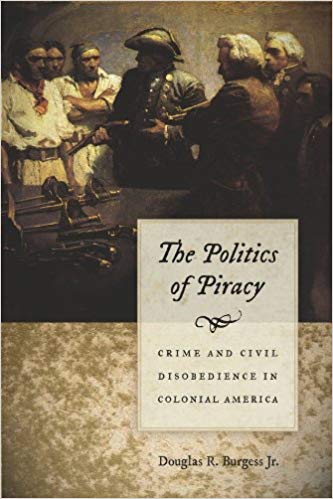
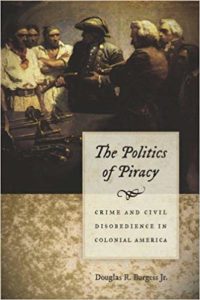
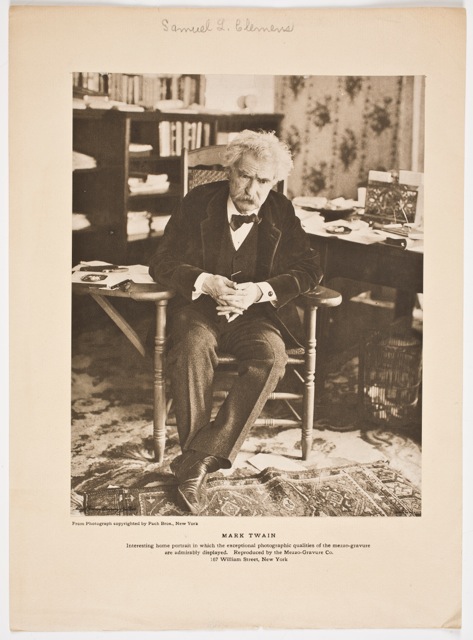

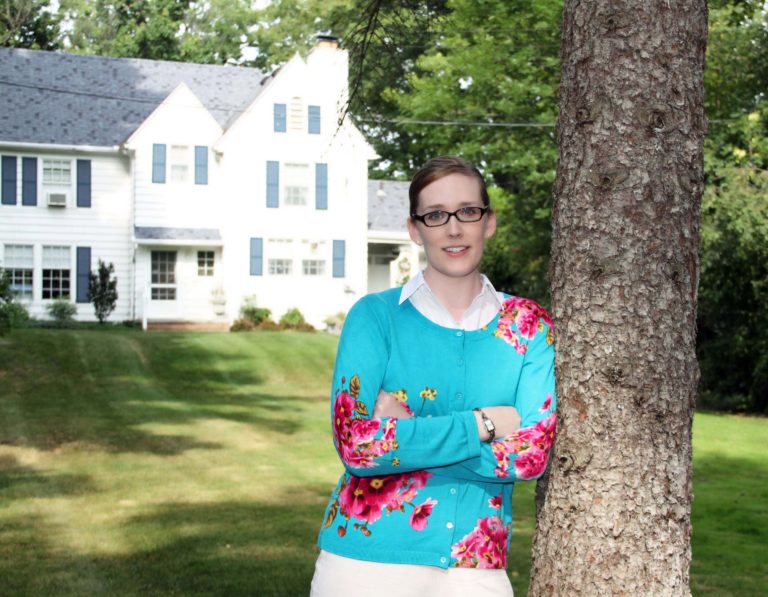



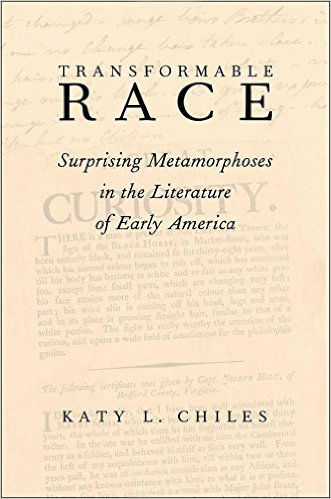




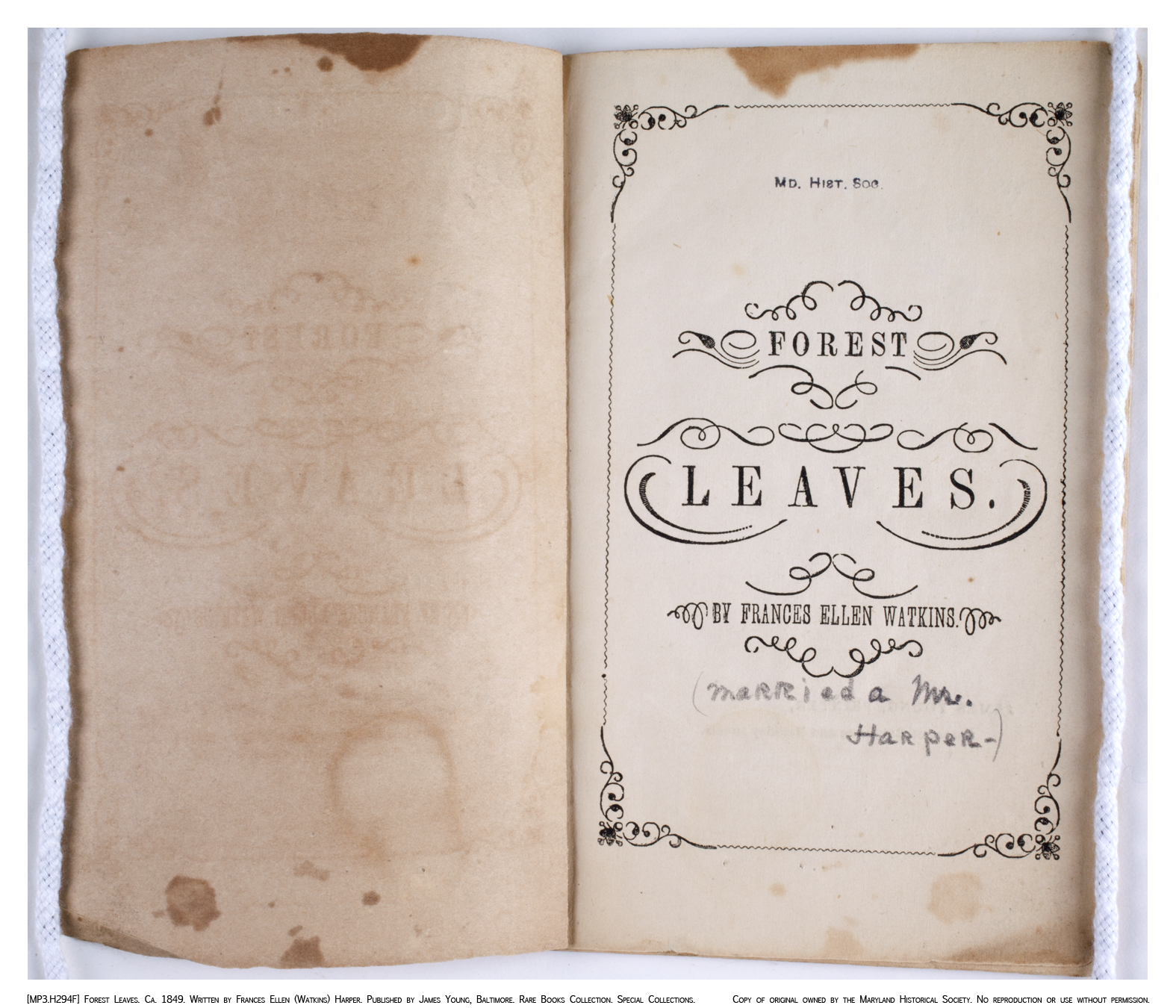
![Title page from Forest Leaves by Frances Ellen Watkins, more commonly known as Frances Ellen Watkins Harper (Baltimore, Maryland, late 1840s). Courtesy of the Maryland Historical Society, [MP3.H294F].](https://commonplace.online/wp-content/uploads/2015/09/mp3-h294f_01-203x300.jpg)
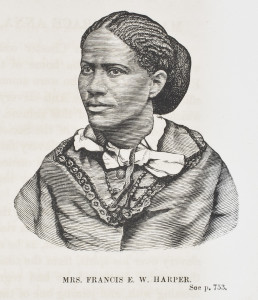
![The first page of Frances Ellen Watkins Harpers’ Forest Leaves. Courtesy of the Maryland Historical Society, [MP3.H294F].](http://commonplace.wpengine.com/wp-content/uploads/2015/09/mp3-h294f_02-300x257.jpg)


